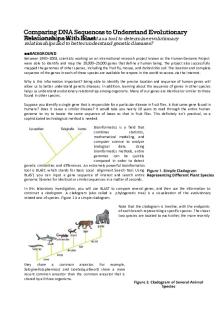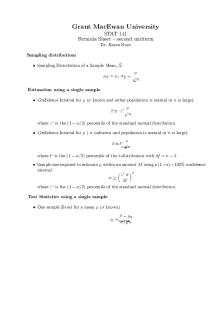Pre Eclampsia - Lecture notes 2 PDF

| Title | Pre Eclampsia - Lecture notes 2 |
|---|---|
| Course | Medicine and Surgery |
| Institution | Lancaster University |
| Pages | 6 |
| File Size | 95 KB |
| File Type | |
| Total Downloads | 10 |
| Total Views | 138 |
Summary
Pre-eclampsia diagnosis, investigations, risks and management...
Description
MBChB Pre-Eclampsia 1. 1.
Describe the classifications of hypertensive disorders of pregnancy. Pre-eclampsia o Can have normal BP changes during pregnancy BP dependent on CO and SVR Normally falls to minimum in 2nd trimester due to reduced SVR o In HTN - increase in SVR causes increase BP o Classification of hypertensive disorders in pregnancy Pregnancy induced HTN When BP >140/90 after 20w gestation de novo Can be due to Pre-eclampsia - disorder of HTN + proteinuria appearing in 2nd half of pregnancy Occurs earlier than 20w in molar pregnancies Gestational (non-proteinuric HTN) - new HTN presenting in 2nd half without proteinuria Pre-existing / chronic HTN When BP >140/90 before pregnancy or before 20w gestation May already be on anti-HTN meds Classification Primary Secondary - may be due to renal disease etc. May be accompanied by proteinuria Higher risk of developing pre-eclampsia
1.
Demonstrate an understanding of severe pre-eclampsia and eclampsia including the use of anti-hypertensives and magnesium sulphate. Formulate a management plan for women suffering from pre-eclampsia including the use of anti-hypertensives. Pre-eclampsia o Multi-system disease - usually manifests as HTN and proteinuria o Peculiar to pregnancy - of placental origin Cured by delivery o Blood vessel endothelial cell damage With maternal inflammatory response --> vasospasm / increased capillary permeability / clotting dysfunction o Characterised by HTN >140/90 Proteinuria >0.3g / 24hr Occurs after 20w gestation Normalises after delivery of foetus o Classification Mild - proteinuria + mild-moderate HTN Moderate - proteinuria + severe HTN without maternal complication Severe - proteinuria + severe HTN + maternal complications o Aetiology Placental disease Causes unknown Risk factors
High risk Previous severe early-onset pre-eclampsia Chronic HTN DM AI disease e.g. antiphospholipid syndrome / SLE / thrombophilia Moderate risk 1st pregnancy - most at risk ? Association with abnormal immunological response to foetal genome Don’t know how they will react as not been pregnant before >40y/o Pregnancy interval >10y BMI >30 FHx of pre-eclampsia Multiple pregnancy - if 2 placentas! Uterine artery notching on Doppler IF 1 HIGH RISK + 2 MODERATE RISK - TAKE ASPIRIN 75MG FROM 12W UNTIL DELIVERY Pathophys Stage 1 - development of disease - occurs between 12-13wks of pregnancy Normal pregnancy - trophoblastic invasion of spiral arterioles --> vasodilation of vessel walls In pre-eclampsia - invasion is incomplete Impaired maternofoetal interaction - may be caused by altered immune responses Incomplete invasion --> spiral arteriole channels not widened Doesn’t create that low resistance circuit Spiral arterioles may contain atheromatous lesions resulting in decreased uteroplacental blood flow "Factor X" - mediatory factor released by placenta Creates physical manifestations of pre-eclampsia Causes widespread effects on endothelium throughout the body Pre-eclampsia is a multi-system disorder Stage 2 - manifestation of disease Ischaemic placenta - exaggerated by maternal inflammatory response "Factor X" - mediatory factor released by placenta Creates physical manifestations of pre-eclampsia Causes widespread effects on endothelium throughout the body Pre-eclampsia is a multi-system disorder Induces widespread endothelial cell damage causing: Vasoconstriction/vasospasm - increased vascular resistance--> HTN Increased vascular permeability - proteinuria + oedema
o
Endothelial cell damage --> platelets used --> overall reduction in platelets in blood Reduced placental blood flow - IUGR Reduced cerebral perfusion - eclampsia Cerebral oedema - headaches / visual disturbances In pre-eclampsia - don’t get the physiological 40% increase in blood
volume o
Already under-perfused Means they can't tolerate blood loss
Clinical features Sx
Can be Asx Headaches Drowsiness Visual disturbances N+V PV bleeding - ?abruption Epigastric pain / RUQ pain - Glisson capsule pain Tonic clonic seizures - severe (eclampsia)
Signs
HTN
o
Severe pre-eclampsia >160/110 Proteinuria May have foetal growth restriction - SGA Foetal compromise on USS Reduced liquor volume - OLIGOHYDRAMNIOS Uterus feels full of foetus - feels like less fluid Oedema ?abruption - woody ward uterus
Investigations First line BP Urine dip - rule out infection ALSO ?PROTEIN - TRACE/+/++ If +/++ Further investigation --> PCR Protein-creatinine ratio (PCR) >30mol/mL protein Limit is 50 in non-pregnant patients May be high when do it for the 1st time + If repeat could get completely different value Monitor maternal complications Bloods FBC U+Es Increased uric acid + creatinine Increased Hb Fall in platelets Rise in liver enzymes - ALT/ALP Rise in LDH with liver disease Long aPPT + PT
o
Neuro exam - hyperreflexia, clonus, loss of patellar reflexes Fundoscopy - papilloedema Monitor foetal complications USS Umbilical A Doppler CTG Management 1+ foetal/ maternal complications likely to occur within 2w of onset of proteinuria Assessment Women w new HTN have BP + urine rechecked Pts without proteinuria + mild/moderate HTN managed as outpts BP + urinalysis repeated twice weekly USS in 2-4w Admission Necessary when Symptomatic Proteinuria 2+ on dipstick OR >0.3g/24hr BP >160/110 Suspected foetal compromise Principles of management - when BP >160/110 Control HTN Using known drugs Don’t want the BP so low that it reduces foetal perfusion Drugs Methyldopa Takes a long time to act Normally used for chronic HTN in early pregnancy Labetalol Alpha and beta blocker - CI in asthma Can be given in early pregnancy some increased risk of SGA babies Nifedipine CCB ACEi contraindicated! teratogenic as affect foetal urine production Prevention of convulsions Magnesium sulphate Used for treatment + prevention of pre-eclampsia IV loading dose followed by IV infusion Not an anticonvulsant but treats eclampsia by increasing cerebral perfusion Delivery baby If baby is delivery whatever the gestation Mode of delivery o Before 34w - CS o After 34w
IOL w PGs and epidural analgesia - helps reduce BP Anti-HTN drugs used in labour Maternal pushing should be avoided in 2nd stage if BP reaches 160/110
Raises intracranial pressure Risks cerebral haemorrhage Oxytocin instead of ergometrine in 3rd stage Ergometrine increases BP
Post-natal care o Post-delivery 24h important o Disease can still manifest then o Monitor Bloods Fluid balance - if CVP high - give furosemide If low give albumin BP...
Similar Free PDFs

Pre Eclampsia - Lecture notes 2
- 6 Pages

Pre-Eclampsia - case study
- 2 Pages

Nursing Skill Pre Eclampsia
- 1 Pages

Blast Pre Lab - Lecture notes 2
- 4 Pages

PSYC Lecture pre midterm Notes
- 18 Pages

Lecture notes, lecture 2
- 3 Pages

2 - Lecture notes 2
- 5 Pages

Pre Lab 2 - Pre lab report 2
- 3 Pages

Lecture notes, lecture Chapter 2
- 11 Pages

Lecture notes, lecture formula 2
- 1 Pages
Popular Institutions
- Tinajero National High School - Annex
- Politeknik Caltex Riau
- Yokohama City University
- SGT University
- University of Al-Qadisiyah
- Divine Word College of Vigan
- Techniek College Rotterdam
- Universidade de Santiago
- Universiti Teknologi MARA Cawangan Johor Kampus Pasir Gudang
- Poltekkes Kemenkes Yogyakarta
- Baguio City National High School
- Colegio san marcos
- preparatoria uno
- Centro de Bachillerato Tecnológico Industrial y de Servicios No. 107
- Dalian Maritime University
- Quang Trung Secondary School
- Colegio Tecnológico en Informática
- Corporación Regional de Educación Superior
- Grupo CEDVA
- Dar Al Uloom University
- Centro de Estudios Preuniversitarios de la Universidad Nacional de Ingeniería
- 上智大学
- Aakash International School, Nuna Majara
- San Felipe Neri Catholic School
- Kang Chiao International School - New Taipei City
- Misamis Occidental National High School
- Institución Educativa Escuela Normal Juan Ladrilleros
- Kolehiyo ng Pantukan
- Batanes State College
- Instituto Continental
- Sekolah Menengah Kejuruan Kesehatan Kaltara (Tarakan)
- Colegio de La Inmaculada Concepcion - Cebu





